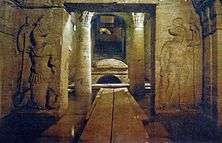Catacombs of Kom El Shoqafa
|
Lofus Kiramaikos (Greek) Ra-Qedil (Egypt) | |
 | |
| Coordinates | 31°10′43″N 29°53′35″E / 31.178558°N 29.892954°E |
|---|---|
| Location | Alexandria, Egypt |
| Type | Tomb, burial chamber, necropolis |
| Height | 100 feet |
| Beginning date | 2nd century |
The catacombs of Kom Kom El Shoqafa (meaning "Mound of Shards") is a historical archaeological site located in Alexandria, Egypt and is considered one of the Seven Wonders of the Middle Ages.
The necropolis consists of a series of Alexandrian tombs, statues and archaeological objects of the Pharaonic funeral cult with Hellenistic and early Imperial Roman influences. Due to the time period, many of the features of the catacombs of Kom El Shoqafa merge Roman, Greek and Egyptian cultural points; some statues are Egyptian in style, yet bear Roman clothes and hair style whilst other features share a similar style. A circular staircase, which was often used to transport deceased bodies down the middle of it, leads down into the tombs that were tunneled into the bedrock during the age of the Antonine emperors (2nd century AD).[1] The facility was then used as a burial chamber from the 2nd century to the 4th century, before being rediscovered in 1900 when a donkey accidentally fell into the access shaft. To date, three sarcophagi have been found, along with other human and animal remains which were added later. It is believed that the catacombs were only intended for a single family, but it is unclear why the site was expanded in order to house numerous other individuals.
Another feature of the catacombs is the Hall of Caracalla, which contains the bones of young Christian men massacred by order of the emperor Caracalla in 215 AD.[2]
Name
The catacombs were named Kom El Shoqafa, meaning Mound of Shards, because the area used to contain a mound of shards of terra cotta which mostly consisted of jars and objects made of clay. These objects were left by those visiting the tombs, who would bring food and wine for their consumption during the visit. However, they did not wish to carry these containers home from this place of death so they would break them. At the time of the discovery, heaps of these broken plates were found.[3]
Layout

The catacombs lie on the western necropolis of Alexandria and consist of three levels cut through solid rock, the third level being now completely underwater. The catacombs have a six-pillared central shaft which opens off the vestibule. On the left is a triclinium, a funeral banquet hall where friends and family gathered on stone couches covered with cushions, both at the time of burial and also on future commemorative visits.[4]
A stone staircase descends to the second level, an area eerily alive with sculptures. In the lobby of the building two pillars are topped by the papyrus, lotus, and acanthus leaves of ancient Egypt and two falcons flanking a winged sun decorate the frieze. Figures of a man and a woman are carved into the wall. The man’s body has a stiff hieratic pose typical of Ancient Egyptian sculpture, with the head carved in the lifelike manner of the classic Hellenes. The woman’s figure is also rigidly posed but bears the Roman hairstyle.
There are three huge stone coffins with non-removable covers along the sides of the chamber. It’s assumed that bodies were inserted in them from behind, using a passageway which runs around the outside of the funeral chamber. There is a hallway with 91" deep walls in the central tomb chamber, with carved recesses, each providing burial space for three mummies.
Visitors can reach the first level through a breach in the rotunda wall, which was made at an unknown date. This leads to the Hall of Caracalla in which the bones of horses and humans were found.[5]
References
- ↑ http://www.lonelyplanet.com/egypt/mediterranean-coast/alexandria/sights/historic/catacombs-kom-ash-suqqafa
- ↑ Zahraa Adel Awed (2006-05-18). "The catacombs of Kom El Shoqafa, the Mound of Shards, Part III: The Hall of Caracalla (Nebengrab)". Tour Egypt. Retrieved 2008-01-22.
- ↑ "The catacombs of Kom El Shoqafa in Alexandria, Egypt". Vantage Travel. Retrieved July 19, 2012.
- ↑ http://www.lonelyplanet.com/egypt/mediterranean-coast/alexandria/sights/historic/catacombs-kom-ash-suqqafa
- ↑ "Catacombs of Kom el Shoqafa Travel and Tour". Travel and Tour. October 2011. Retrieved July 19, 2012.